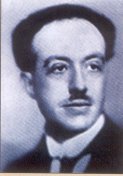- It worked only for hydrogen and hydrogen-like atoms and radiation. Attempts at extending the hydrogen theory to more complex atoms exposed new difficulties.
- Some of the spectral lines were shown to possess fine structures. At first some refinements to the Bohr theory seemed to account for such results, but their brightness could not be accounted for.
The Double-Slit Experiment
Meanwhile, another simple experiment baffled physicists, because classical physics fails to explain the results. This well-known experiment is called the 'double slit experiment'. To simplify the discussion a bit we shall talk about holes instead of slits. Briefly, the experiment is as follows.- The setup comprises a stream of electrons hitting a wall with two small holes. A heated filament is a good source of electrons. A constant voltage applied between the source and the wall with two holes ensures that electrons arrive at the holes with the same momentum. An electron detector at the screen detects the rate of arrival of electrons.
- If we move the detector very slowly up or down, it will be found that the rate goes through maxima and minima reminiscent of the interference pattern [1] associated with waves described above, but the detected individual electrons are always point-like, never smeared out. If we close one of the holes, the interference pattern is lost, and an image of the open hole is seen.
- Suppose we drastically reduce the electron emission rate, to such a level that the source emits only one electron at a time, at random intervals. We expect that each electron passes through only one of the two holes. For the electron that passes through one hole, whether the other hole is open or closed should not matter. Astonishingly, interference fringes still build up on the screen if the experiment runs long enough.
De Broglie's Explanation
In 1924 Louis de Broglie, an imaginative French physicist, asserted that material particles would behave as waves under certain conditions, and vice versa. He argued that just as light waves behave as particles to give rise to photoelectric effect, matter also would behave as waves under certain conditions. He even gave a simple formula to calculate the wavelength [2] associated with electrons of a given momentum.
It might surprise you that the de Broglie wavelength associated with photons is equal to the usual electromagnetic wavelength. Ordinary objects, such as balls and bullets, also have de Broglie waves associated with them, but the wavelengths are so small that they can be neglected. Only we enter the sub-atomic domain do they gain significance.
This idea of matter waves at first seemed very speculative, and failed to attract attention. In 1927, however, it was experimentally confirmed to be true by Davisson and Germer at the Bell Laboratories, after conducting studies on scattering of electron beams from crystals.
Decades later, today, the wave nature of matter is taken almost
for granted. Diffraction studies involving beams of electrons
or neutrons are used routinely to study the atomic structures of
solids and liquids. Matter waves are a valuable supplement to
X-rays in such studies. Electron microscopes, which employ
electron beams, have revolutionised microbiology and significantly
improved our understanding of living organisms. High-energy
particle accelerators probe extremely small space and time
intervals using the same principle.
Returning to our atom, de Broglie waves clarify the ad hoc quantum condition of Bohr's atom. Allowed orbits are only those for which the orbit length equals an integral multiple of electron wavelengths. All other orbits disappear due to destructive interference.
Nevertheless, objections to Bohr's theory continued to persist due to its drawbacks mentioned above; a large number of generalisations and modifications to Bohr's theory were tried, but they were all complicated and unsatisfactory.
The breakthrough came soon, as the next chapter uncovers.
Footnotes
1. Interference is a phenomenon in which two or more waves superpose to yield a resultant wave whose amplitude or intensity may be greater or less than the component waves. The striking colours on soap bubbles and oil slicks are due to interference of light waves. Back2. Wavelength is a measure of the length of a wave, and is given by the distance between two consecutive 'crests' or 'troughs' of the wave. If you measure the distance between two 'heads' of a ripple in a pond as 10 cm, then its wavelength is said to be 10 cm. Back